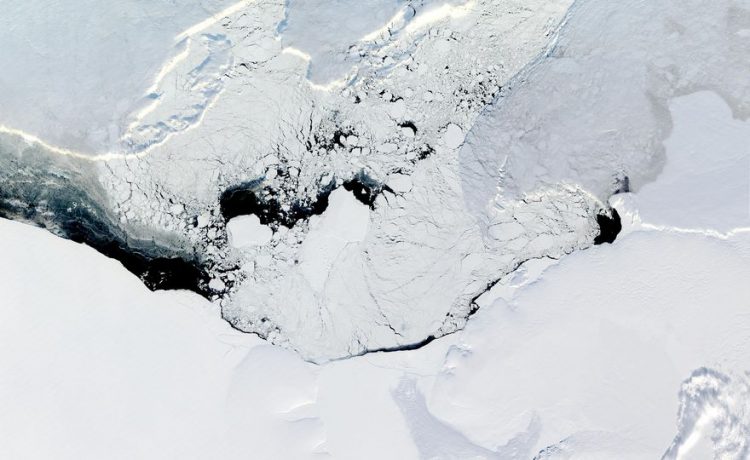The warmer the higher: sea-level rise from Filchner-Ronne ice in Antarctica

The Filchner-Ronne ice shelf is the second largest ice shelf in Antarctica. Photo: NASA Visible Earth
Published in Nature Climate Change, their study shows that in this area the ice flow into the ocean increases just constantly with the heat provided by the ocean over time.
“While for other parts of Antarctica unstoppable long-term ice loss might be provoked by a single warming pulse, caused by nature itself or human action, ice loss in the Filchner-Ronne region increases directly with ocean warming,” lead author Matthias Mengel explains. “This is good news, because it is in our hands to determine how much the region contributes to the global sea-level rise.” Ocean warming results from greenhouse gases in the atmosphere, produced by humankind’s unabated burning of coal, oil and gas. Importantly, however, the oceans might not respond linearly to atmospheric warming, and not in the same way in all parts of the world. This includes the risk that ocean temperatures first lag behind, and then rise rapidly.
“Good news” – yet only compared to other parts of the ice continent
The Filchner-Ronne shelf covers an area bigger than Germany; its grounded-ice tributaries store water equivalent to a total of several meters of sea-level rise. “Our calculations show that this relatively small part of the Antarctic ice sheet within just 200 years of unabated climate change could contribute up to 40 centimeters to global sea-level rise,” says Mengel. “This kind of sea-level rise alone could already be enough to bring coastal cities like Hamburg into serious difficulties.”
“At present, most Antarctic ice shelves are surrounded by cold water masses near the freezing point,” co-author Anders Levermann says. “The topography around the ice continent acts as a barrier for heat and salt exchange with the northern warmer and saltier water masses, creating a cold water wall around the continent”. Projections of the breakdown of this front in ocean simulations for the Filchner-Ronne region under atmospheric warming raised concerns that such ocean instability might lead to unstoppable future ice loss also from this part of Antarctica, as is projected to occur in the Wilkes Basin region, for instance. “We found that this is not the case for the Filchner-Ronne shelf – which luckily means that we can still very well limit the ice loss in this area by limiting greenhouse gas emissions.”
Different mechanisms in different regions
Sea-level rise poses a challenge to coastal regions worldwide. While today sea-level rise is mainly caused by thermal expansion of the warming oceans, and by the melting of mountain glaciers, the major contributors to long-term future sea-level rise are expected to be Greenland and Antarctica with their vast ice sheets. The causes of ice loss differ greatly between the two. While on Greenland ice melting at the surface plays a large role, the Antarctic ice sheet loses almost all its ice through ice flow into the ocean. The simulation of the Antarctic ice flow is complex because the flow can become unstable. Ice shelves, the floating extensions of the ice sheet, can act as a break to the ice flow and inhibit instability. Warming oceans around Antarctica that melt the ice shelves therefore increase the risk of high sea-level rise.
The Parallel Ice Sheet Model, as used by the authors, resolves unstable grounding line retreat and simulates the flow of both the ice sheet and the ice shelves. It can therefore help to answer urgent questions as to the extent of Antarctica’s sea-level risks.
“It is more difficult to determine the risk that comes with global warming in parts of Antarctica that are considered unstable, and less difficult for the Filchner-Ronne region that responds linearly to global warming,” concludes Levermann. “One thing is clear: the more warming we cause by burning coal, gas and oil, the more expensive it will be for coastal regions to adapt.”
Article: Mengel, M., Feldmann, J., Levermann, A. (2015): Linear sea-level response of Antarctic tributaries to strong projected ocean warming underneath the Filchner-Ronne ice shelf. Nature Climate Change (Advance Online Publication) [DOI: 10.1038/nclimate2808]
Link to the article once it is published: http://dx.doi.org/10.1038/nclimate2808
Link to the previous study on the Wilkes Bassin, “Uncorking East Antarctica yields unstoppable sea-level rise”:
https://www.pik-potsdam.de/news/press-releases/archive/2014/uncorking-east-antar…
Media contact:
PIK press office
Phone: +49 331 288 25 07
E-Mail: press@pik-potsdam.de
Twitter: @PIK_Climate
Media Contact
More Information:
http://www.pik-potsdam.deAll latest news from the category: Earth Sciences
Earth Sciences (also referred to as Geosciences), which deals with basic issues surrounding our planet, plays a vital role in the area of energy and raw materials supply.
Earth Sciences comprises subjects such as geology, geography, geological informatics, paleontology, mineralogy, petrography, crystallography, geophysics, geodesy, glaciology, cartography, photogrammetry, meteorology and seismology, early-warning systems, earthquake research and polar research.
Newest articles

First-of-its-kind study uses remote sensing to monitor plastic debris in rivers and lakes
Remote sensing creates a cost-effective solution to monitoring plastic pollution. A first-of-its-kind study from researchers at the University of Minnesota Twin Cities shows how remote sensing can help monitor and…

Laser-based artificial neuron mimics nerve cell functions at lightning speed
With a processing speed a billion times faster than nature, chip-based laser neuron could help advance AI tasks such as pattern recognition and sequence prediction. Researchers have developed a laser-based…

Optimising the processing of plastic waste
Just one look in the yellow bin reveals a colourful jumble of different types of plastic. However, the purer and more uniform plastic waste is, the easier it is to…



